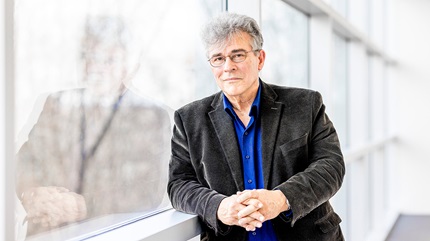
Throughout her career, Marie Umholtz was the voice for those who weren’t able to speak for themselves — as a social worker, a family law lawyer and a mediation magistrate in domestic relations court. Now, she continues that calling as a volunteer helping victims of human trafficking.
A few years before she retired in 2018, Marie, a 71-year-old Burton resident, noticed gradual changes in her voice. She began to have trouble speaking and her voice sounded shaky.
“At the beginning, my voice issues were problematic but not problematic enough to warrant treatment,” recalls Marie. “But over the years, it became increasingly difficult and exhausting.”
In her mind, the vocal tremor was the least of her problems. Not being able to participate in everyday conversations was what really bothered her.
“I had to think about how to form sentences and what I was saying. I couldn’t actively participate. By the time I could get a sentence out, the people I was with were already on another topic. It was so exhausting and stressful. It literally drained me,” says Marie.
Her primary care provider prescribed medication which didn’t help. She made an appointment with an otolaryngologist, but after she saw him, he retired. And then the COVID-19 lockdown happened.
During the lockdown, Marie searched the internet and came across Paul Bryson, MD, MBA, laryngologist and Director of Cleveland Clinic’s Voice Center. Dr. Bryson specializes in voice, airway, and swallowing disorders involving the voice box and throat.
“I like to have the best of the best when it comes to my healthcare. When I read about Dr. Bryson’s experience, I knew I could trust him with my vocal issues,” says Marie.
In August 2021, Marie had her initial consultation with Dr. Bryson.
“After listening to Marie’s speech and examining her larynx and pharynx with a scope, I determined she had vocal tremor with adductor spasmodic dysphonia, which caused her vocal cords to spasm and tighten. This gave her trouble speaking and made her voice sound strained, breathy or shaky,” explains Dr. Bryson.
To develop Marie’s care plan, he worked with Claudio Milstein, PhD, a speech-language pathologist and Director of Cleveland Clinic’s Voice Center. They decided that Botox injections would improve voice production and dampen the tremor.
“At the Voice Center, we work as a team to develop personalized treatment for our patients. says Dr. Milstein. “I use electromyography to evaluate the electrical activity in the muscles to guide where the needle should be placed in Marie’s vocal cords. Dr. Bryson executes the injections.”
In September 2021, Marie had her first laryngeal Botox injections. The procedure took about 10 to 15 minutes. And, about eight hours later, the medication took effect.
“I was a little apprehensive the first time, but once I saw how easy it was and the relief I got, the nervousness disappeared,” says Marie.
Marie continues to get Botox injections on each side of her neck every four to five months.
“Marie has a nice benefit from the injections. Her condition will require treatment over the course of her lifetime, but the injections allow her to be more engaged and to feel like herself,” says Dr. Bryson.
The injections also help her to continue to be the voice of women who were victims of human trafficking.
“I cried happy tears after the first procedure. Because of the care and kindness of Drs. Bryson and Milstein, I got my voice back and can continue to advocate for women who are exploited and need someone to speak up for them,” says Marie.
Related Institutes: Head & Neck InstitutePatient Stories
Cochlear Implant Surgery Enables Akron Pastor To Enjoy Sounds He Hasn’t Heard in Years
Feb 22, 2024
“My cochlear implant is astounding. I’ve been able to hear sounds I haven’t heard in years — birds chirping, the tones and notes of the golden 60s music, and chopping of vegetables. I was in my office upstairs in my home and heard someone talking. It was my wife who was downstairs on her phone. I’m no longer in a silent world, and it’s amazing.”


